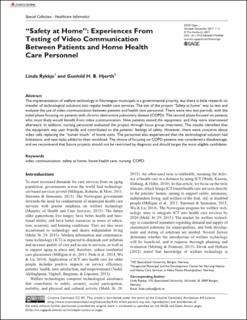| dc.contributor.author | Rykkje, Linda | |
| dc.contributor.author | Hjorth, Gunhild | |
| dc.date.accessioned | 2022-12-16T10:39:04Z | |
| dc.date.available | 2022-12-16T10:39:04Z | |
| dc.date.created | 2017-12-11T08:41:00Z | |
| dc.date.issued | 2017 | |
| dc.identifier.citation | Sage Open. 2017, 7 (4), 1-11 | en_US |
| dc.identifier.issn | 2158-2440 | |
| dc.identifier.uri | https://hdl.handle.net/11250/3038238 | |
| dc.description | This article is distributed under the terms of the Creative Commons Attribution 4.0 License (http://www.creativecommons.org/licenses/by/4.0/) which permits any use, reproduction and distribution of the work without further permission provided the original work is attributed as specified on the SAGE and Open Access pages (https://us.sagepub.com/en-us/nam/open-access-at-sage) | en_US |
| dc.description.abstract | The implementation of welfare technology in Norwegian municipals is a governmental priority, but there is little research on transfer of technological solutions into regular health care services. The aim of the project “Safety at home” was to test and evaluate the use of video communication between patients and health care personnel. There were two test periods, with the initial phase focusing on patients with chronic obstructive pulmonary disease (COPD). The second phase focused on patients who most likely would benefit from video communication. Nine patients tested the equipment, and they were interviewed afterward. In addition, nursing personnel evaluated the project through focus group interviews. The results identified that the equipment was user friendly and contributed to the patients’ feelings of safety. However, there were concerns about video calls replacing the “human touch” of home visits. The personnel also experienced that the technological solution had limitations, and new tasks added to their workload. The choice of focusing on COPD patients was considered a disadvantage, and we recommend that future projects should not be restricted by diagnosis and should target the most eligible candidates. | en_US |
| dc.language.iso | eng | en_US |
| dc.publisher | Sage | en_US |
| dc.rights | Navngivelse 4.0 Internasjonal | * |
| dc.rights.uri | http://creativecommons.org/licenses/by/4.0/deed.no | * |
| dc.subject | COPD | en_US |
| dc.subject | nursing | en_US |
| dc.subject | home health care | en_US |
| dc.subject | safety at home | en_US |
| dc.subject | video communication | en_US |
| dc.title | “Safety at home”: Experiences from testing of video communication between patients and home health care personnel | en_US |
| dc.type | Peer reviewed | en_US |
| dc.type | Journal article | en_US |
| dc.description.version | Published version | en_US |
| dc.rights.holder | © The Author(s) 2017 | en_US |
| dc.source.pagenumber | 1-11 | en_US |
| dc.source.volume | 7 | en_US |
| dc.source.journal | Sage Open | en_US |
| dc.source.issue | 4 | en_US |
| dc.identifier.doi | https://doi.org/10.1177/2158244017744900 | |
| dc.identifier.cristin | 1525402 | |
| cristin.unitcode | 251,3,0,0 | |
| cristin.unitname | Fakultet for helsefag | |
| cristin.ispublished | true | |
| cristin.fulltext | postprint | |
| cristin.qualitycode | 1 | |

